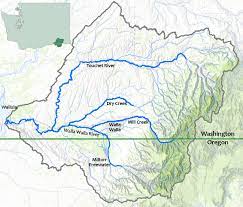Communities, industries, farms and endangered fish in both Washington and Oregon depend on the Walla Walla River Basin where streamflows and aquifers have steadily declined, despite a decades-long effort to find lasting water solutions in the region.
In October 2019, the Washington Department of Ecology and the Walla Walla Watershed Management Partnership convened a new initiative called Walla Walla Water 2050 to tackle the many challenges facing the basin. In concert with the Confederated Tribes of the Umatilla Indian Reservation, the state of Oregon and numerous stakeholders, they developed an integrated approach for water management in the Walla Walla basin.
The Walla Walla River subbasin is located within the northeast portion of the aboriginal title lands of the Confederated Tribes of the Umatilla Indian Reservation. The headwaters of the Walla Walla River are in the Blue Mountains and contain important salmonid production areas for summer steelhead, rainbow trout, bull trout, mountain whitefish, and reintroduced spring chinook. The Walla Walla River enters the Columbia River at roughly river mile 315.
After 18 months of collaboration, the Walla Walla Strategic Plan Advisory Committee is now unveiling a framework for managing water over the next 30 years. Comments on the draft Walla Walla Water 2050 Strategic Plan will be accepted through May 24, 2021. A final plan is due June 30, 2021.
The Walla Walla River and its tributaries, including Mill Creek and the Touchet River, support irrigated crops, community drinking water, endangered species habitat and recreational tourism. Many years, there may be flooding from rapid runoff or shortages when there’s not enough water to go around. With its headwaters in Oregon south of Milton-Freewater, the watershed carries unique constraints, including how to reconcile different regulatory approaches in the two states.
In facilitated sessions, advisory committee members and various working groups met in person and virtually to address these challenges. The plan they hammered out describes current watershed conditions and the desired future conditions needed to achieve water security, and identifies short- and long-term strategies to meet these goals.
The plan lists opportunities for new water supplies and mechanisms to restore floodplains and reduce flood risks, improve habitat, and meet water quality goals for threatened fish. Climate change resiliency, along with science and monitoring to support adaptive management, are other important goals laid out in the plan.
Once the planning document is finalized, the Walla Walla Water 2050 Strategic Plan Advisory Committee will be tasked with developing governance and funding strategies to implement the plan.

